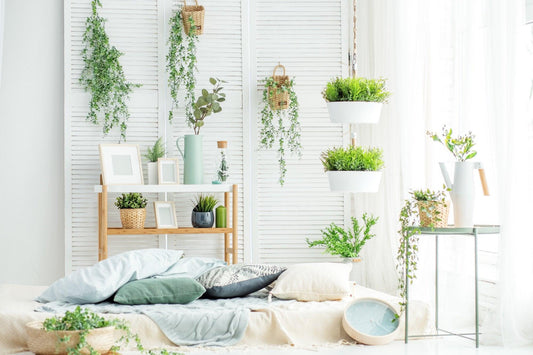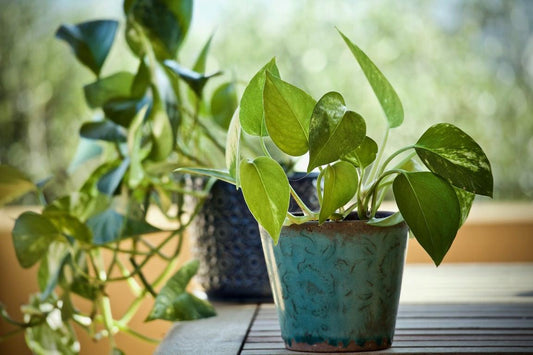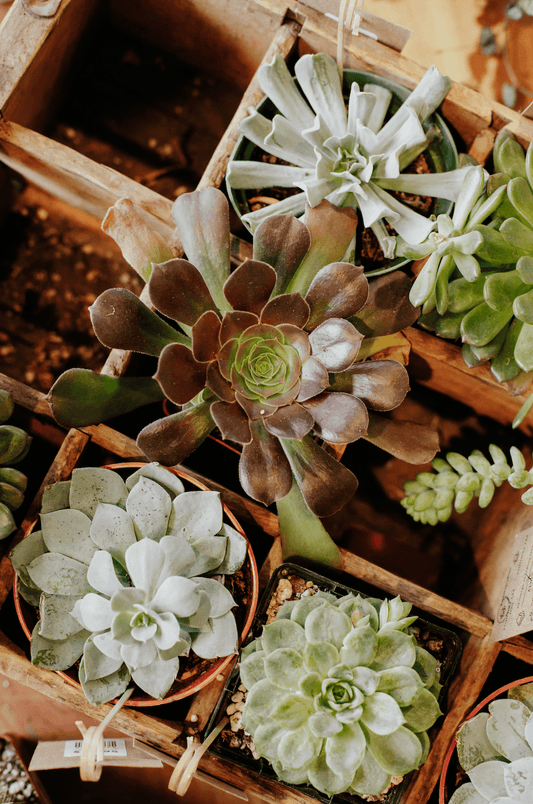Succulents
How to Care for Succulents
Overview
Succulents are low-maintenance plants that can add color and texture to your home. They're perfect for beginners since they need little care—and even experts enjoy collecting all the different varietals. The key to keeping succulents healthy is providing plenty of light and letting the soil dry out 90-100% between waterings.
Succulents are drought-tolerant plants that require little water once established. While they can survive on very little water, succulents need a steady supply of soil moisture for optimal growth and development. It's important to note that some varieties will tolerate more neglect than others. Heartier succulents are more stocky and have thick, fleshy leaves. They can handle more neglect than thin-leaved varieties.
Succulents are unique because they have thick leaves and stems, which help them store water in their leaves so they can survive long periods of drought. They are native to hot, dry climates like deserts or savannahs.


Profile
Succulents prefer bright, indirect light. Place your succulent in a sunny window that receives at least six hours of afternoon sunlight, but try to avoid the harsher morning light until you are sure your plants are acclimated to higher-intensity light. If you do not have such a window, artificial light sources (like grow lights or fluorescent bulbs) can provide sufficient illumination for the plant to thrive.
Succulents should be watered when the top 90% of the soil is dry. You can allow the bottom 10% to be wet, which will allow succulents to continue growing quickly. In the wintertime, let them dry out 100% and wait for the leaves to become wilted between waterings. You really want to limit growth during the winter because they can get very thin and leggy when they grow with less than full sun.
This will mean that the soil will become hydrophobic. That means that the cellular structure of the soil will be closed and water will run right through the soil. To combat that, let the soil soak in the water for multiple minutes. Either by immersing the soil in water, bottom watering, or watering and then re-watering once the cell structure has opened up.




Low light
Succulents are often desert plants, they will take as much sun as you can. This is why succulents can live outdoors during the summer, either in a pot or in the ground, if it is warm enough. When indoors, succulents would love to live on a very bright window sill or under an artificial light designed to give full-sun plants more light. If it is not getting enough sun, your succulent will become elongated and leggy, meaning it will reach for the light while growing, creating a plant that is more stem than foliage. Once this happens, it won’t return to its smaller, compacted size unless seriously pruned back.

Occasional
Most succulents have thick, meaty leaves in order to retain water. Too much water will cause rot. Water when the soil is 100% dry, and then some. Check the soil for moisture rather than keeping them on a watering schedule; soil moisture can change depending on the type of pot it is in (terracotta, ceramic, plastic, etc.), how big the pot is, and what time of the year it is. For example, you might only have to water your succulent once every two months in the winter, but the soil dries up much faster in summer heat and sun.

Easy breezy
If you can provide them with full or bright indirect sun, and only water when the soil is fully dried out then you should have an easy time taking care of them.

Pet Friendly
Most succulents are pet-friendly, however, jades, euphorbias, and senicos, such as String of Pearls are toxic.
FREQUENTLY ASKED QUESTIONS (FAQs)
on Succulent
How to repot a succulent?
Succulents can be fragile, so repotting needs to be handled with care. Clean off all the dirt from around the root system—get as much off as you can—before transferring into new soil. An old paintbrush works well for this, but you can just use your hands, too. Succulents like well-draining soil with rockier substrates, like pumice or sand.
Make sure the pot you are repotting your plant in has a drainage hole for water. If it doesn’t, it’s best to repot into a plastic nursery pot and place it in another fun, decorative pot. This allows the non-draining pot to be used as a water catcher, which needs to be dumped of standing water after every water.
Depending on the type of succulent, you might lose a few leaves during the transfer, but this is normal. If your succulent is healthy, it will fill back out.
How do you propagate succulents?
It is very easy to propagate succulents. Succulents reproduce mainly from propagated leaves, as a single leaf has the ability to create an entirely new plant. Succulent seeds are hard to come by and even harder to grow, so most succulents you see were most likely grown from a propagated leaf.
If a healthy leaf drops or gets knocked off, you can lay it gently on top of some soil and ignore it. Within weeks, the leaf will start to root and, eventually, you will see a tiny plant at the base of the leaf. Let the big leaf completely dry up and shrivel away before picking it off; all the water the new plant needs is coming from that parent leaf.
You can also water propagate succulent leaves. Grab a clear jar or glass and fill it halfway with some water. Then, secure some cling wrap over the opening of the jar, making sure it’s pulled taut. Poke holes in the cling wrap that would be big enough for a succulent leaf to fit in, but not big enough for it to fall through. The end of the leaf should be closest to the water when you stick the leaf in. Put this jar in a sunny spot and ignore it. Eventually, it will grow roots and a new plant. The water in the jar makes the roots reach for it as well as creates humidity.
Keep in mind that propagation is never 100% guaranteed. Some leaves won’t make it, but some will. This is normal. Keep trying and eventually, you will succeed in propagating new succulents!
Why is my succulent turning yellow, translucent, and/or mushy?
These are all signs of overwatering. The bottom leaves will show these signs first, as they are closer to the root system. There is a very good chance these leaves will fall off. If you gently squeeze a succulent leaf that looks like this, excess water will easily sponge out of it.
Though you can hope that the soil dries out and only affects a few leaves, the best course of action to ensure the life of your succulent if overwatered is to repot it with drier soil and allow for that soil to fully dry out before watering again. Succulents prefer to go long times in between waterings and dry out 100% of teh way and then some.
If root rot has already set in, you might need to trim off the rotten roots, or even cut off the healthy top of the succulent and allow it to reroot. If you can’t salvage the whole plant, you can take the healthy leaves off and propagate them.
Why are my succulent’s leaves wrinkled?
Wrinkled succulent leaves are caused by the elusive underwatering. This will usually happen after a long, long period of no water. Your succulent has been drinking the stored water in the leaves, and now that that’s depleting, it needs some more water! Double-check your soil to confirm the dryness, then give it a big drink. Don’t let your succulent sit in the excess water, though!




